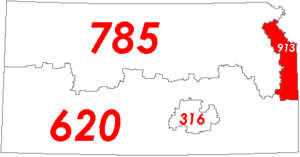Area code 913
Area code 913 is the telephone area code in the North American Numbering Plan (NANP) for northeastern Kansas. The numbering plan area (NPA) consists of a small ribbon of eight counties bordering Missouri—an area largely coextensive with the Kansas portion of the Kansas City Metropolitan Area.

Prior to July 20, 1997, 913 covered all of northern Kansas from the Colorado state line to the Missouri state line.
History
Despite a relatively small population, Kansas was expected to receive the area codes 617 and 618 in the preliminary planning of the North American Numbering Plan by AT&T in 1946.[1] However, sequential regional numbering was abandoned in the final plan of October 1947. Kansas still received two area codes, 316 and 913. The southern half of the state (Dodge City, Emporia, Garden City, Wichita) received 316, while the northern half (Kansas City, Shawnee, Overland Park, Lawrence, Manhattan, Topeka) became numbering plan area 913.
The original configuration was unusual for Kansas, a state which has usually seen east-west geographic disputes. However, a north-south split was deemed necessary because the state's three major metropolitan areas (Kansas City, Topeka, and Wichita), and consequently, most of the state's landlines, are all in the east.
Kansas City's growth necessitates a new code
The two area code configuration of Kansas remained unchanged for more than 40 years. By the mid-1990s, the proliferation of cell phones, the growing population in the Kansas City metropolitan area (most notably Johnson County and Overland Park), and deregulation due to the Telecommunications Act of 1996, the exchanges for area code 913 were quickly being exhausted.
Late in 1996, the Kansas Corporation Commission, which oversees telecommunications in the state, requested relief from the North American Numbering Plan Administrator (NANPA) for the exchanges of area code 913, and on February 12, 1997, the NANPA responded by splitting off the bulk of the old 913 territory—essentially, everything from Lawrence westward—into the new 785 area code. From July 20, 1997 through October 2, 1998, a period of permissive dialing was in use, allowing customers affected by the new area code to use either 913 or 785 when dialing long-distance. On October 3, 1998, the 785 area code became mandatory in the new calling area, and 913 was reduced to the Kansas City area.
Even with the Kansas City area's continued growth, 913 is nowhere near exhaustion. NANPA projections of 2017 estimate that the Kansas side of the Kansas City area will not need another area code until 2045.[2]
Service area
Major cities
Major cities reassigned from NPA 913 to 785
Boundaries
When the 785 split of numbering plan area 913 to removed most of the territory, Wyandotte, Linn, Miami, Johnson, Leavenworth, and Atchison counties kept 913. The city of Elwood, surrounded on three sides by Missouri, retained 913, despite the rest of Doniphan County switching to area code 785. This is because Elwood's wire center is in St. Joseph, Missouri, which is part of the Kansas City LATA. It would have been too expensive for Southwestern Bell to reroute Elwood's traffic so it could follow the rest of Doniphan County into 785.
When all of northern Kansas was still one numbering plan area (913), the boundary ran from west to east roughly following a path along Kansas Routes 4 and 96 from the Colorado state line eastward. The code boundary dipped along Interstate 135 in McPherson County and continued east to just north of Emporia in Lyon County along the Kansas Turnpike, and then all the way to the Missouri state line.
See also
List of NANP area codes
References
- "Google Groups". Groups.google.com. Retrieved 2019-09-16.
- "Exhaust analysis" (PDF). www.nationalnanpa.com. 2017. Retrieved 2019-09-16.
External links
| Kansas area codes: 316, 620, 785, 913 | ||
|---|---|---|
| North: 785 | ||
| West: 785 | area code 913 | East: 660, 816 |
| South: 620 | ||
| Missouri area codes: 314, 417, 573, 636, 660, 816 | ||